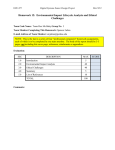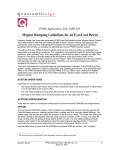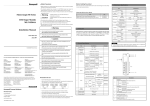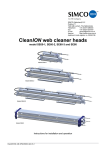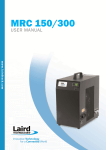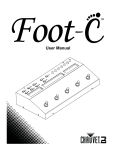Download 802.11g USB Wireless Adapter
Transcript
802.11g USB Wireless Adapter Installation Guide Notice to Users ©2005 2Wire, Inc. All rights reserved. This manual in whole or in part, may not be reproduced, translated, or reduced to any machine-readable form without prior written approval. 2WIRE PROVIDES NO WARRANTY WITH REGARD TO THIS MANUAL, THE SOFTWARE, OR OTHER INFORMATION CONTAINED HEREIN AND HEREBY EXPRESSLY DISCLAIMS ANY IMPLIED WARRANTIES OF MERCHANTABILITY OR FITNESS FOR ANY PARTICULAR PURPOSE WITH REGARD TO THIS MANUAL, THE SOFTWARE, OR SUCH OTHER INFORMATION, IN NO EVENT SHALL 2WIRE, INC. BE LIABLE FOR ANY INCIDENTAL, CONSEQUENTIAL, OR SPECIAL DAMAGES, WHETHER BASED ON TORT, CONTRACT, OR OTHERWISE, ARISING OUT OF OR IN CONNECTION WITH THIS MANUAL, THE SOFTWARE, OR OTHER INFORMATION CONTAINED HEREIN OR THE USE THEREOF. 2Wire, Inc. reserves the right to make any modification to this manual or the information contained herein at any time without notice. The software described herein is governed by the terms of a separate user license agreement. 2Wire, and the 2Wire logo are registered trademarks of 2Wire, Inc. All other trademarks are trademarks of their respective owners. 5100-000245-001 Rev B 2Wire 802.11g Wireless USB Adapter 2Wire’s 802.11g Wireless USB Adapter is a wireless networking device that is connected to a USB port on your computer using a USB cable. Wireless networking provides the same connectivity as Ethernet without the wires. Expanding or redesigning your network is easy, and unlike cabled Ethernet, the 2Wire 802.11g Wireless USB Adapter allows users to roam throughout the home or office while remaining connected to the local area network (LAN). Follow these steps to complete the adapter installation: Step 1 - Install the 2Wire 802.11g Wireless USB Adapter. Step 2 - Install the adapter driver from your 2Wire Wireless Installation CD. The following sections give you detailed instructions for completing each step. 1 Step 1: Install the 2Wire 802.11g Wireless USB Adapter The supplied USB cable has a different type of USB connector on each end. Series A connector. The Series A USB connector plugs into the USB port on your computer. Mini Series B connector. The Series B USB connector plugs into a USB device. To install the 2Wire 802.11g Wireless USB Adapter, simply connect the adapter to an available USB port on your computer using the supplied USB cable. 2 STEP 2: Install the 2Wire 802.11g Wireless USB Adapter Driver Installing Drivers For Windows XP 1. Power on your computer. Insert your 2Wire Wireless Installation CD into your CD-ROM drive. 2. When the Found New Hardware Wizard window opens, select Install the software automatically (Recommended) and click Next to continue. 3 3. The driver installs. 4. When the Completing the Found New Hardware Wizard opens, click Finish. 5. Continue to “Appendix A: Wireless Adapter Configuration” on page 12 to configure the adapter to work with your 2Wire gateway. 4 Installing Drivers for Windows 2000 1. Power on your computer. Insert your 2Wire Wireless Installation CD into the CD-ROM drive. 2. When the Found New Hardware Wizard window opens, click Next to continue. 3. The next window prompts you to install device drivers. Select Search for a suitable driver for my device (recommended), and click Next. 5 4. When the Locate Driver Files window opens, deselect the Floppy disk drives checkbox, select the CD-ROM drives checkbox, and click Next. 5. When the Driver Files Search Results window opens, click Next. 6 6. When the Completing the Found New Hardware Wizard opens, click Finish. Your installation is complete. 7. Continue to “Appendix A: Wireless Adapter Configuration” on page 12 to configure the adapter to work with your 2Wire gateway. Installing Drivers for Windows ME 1. Power on your computer. Insert your 2Wire Wireless Installation CD into your CD-ROM drive. 2. When the Add New Hardware Wizard window opens, select Automatic search for a better driver (Recommended), and click Next. 7 3. After the driver files are copied, click Finish. 4. If the System Settings Change window opens, click Yes to restart your computer. Your installation is complete. 5. Continue to “Appendix A: Wireless Adapter Configuration” on page 12 to configure the adapter to work with your 2Wire gateway. 8 Installing Drivers for Windows 98 SE 1. Power on your computer. Insert your 2Wire Wireless Installation CD into the CD-ROM drive. 2. When the Add New Hardware Wizard opens, click Next to continue. 3. When the next window opens, select Search for the best driver for your device (Recommended), and click Next. 9 4. Deselect the Floppy disk drives checkbox, select the CD-ROM drive checkbox, and click Next. 5. Windows locates the best driver for your device. Click Next to continue. 10 6. After the drivers are copied, click Finish. 7. If the System Settings Change window opens, click Yes to restart your computer. Your installation is complete. 8. Continue to “Appendix A: Wireless Adapter Configuration” on page 12 to configure the adapter to work with your 2Wire gateway. 11 Appendix A: Wireless Adapter Configuration Now that you have installed the drivers for your wireless adapter, you must configure it to work with the 2Wire gateway. A wireless network requires a network name (SSID) and an encryption key to operate. Every 2Wire wireless gateway comes with a unique network name and encryption key printed on the bottom of the unit. 1. With the 2Wire Wireless Installation CD in your CD-ROM drive, click Run from the Windows Start button. In the Open field, enter D:\setup.exe and click OK. If your CD-ROM drive is not located on D:, substitute the appropriate letter (for example, E:\setup.exe). 2. When the Driver and Utilities program page displays, click the Configure 2Wire Wireless Adapter button. 12 3. Enter the serial number and encryption key from your 2Wire wireless gateway, then click the Begin Wireless Configuration button to configure your adapter. 13 Regulatory Information FCC Statement This device has been tested and complies with the specifications for a Class B digital device, pursuant to Part 15 of the FCC rules. These rules are designed to provide reasonable protection against harmful interference in a residential installation. This equipment generates, uses, and can radiate radio frequency energy and, if not installed and used according to the instructions, may cause harmful interference to radio communications. However, there is no guarantee that interference will not occur in a particular installation. If this equipment does cause harmful interference to radio or television reception, which is found by turning the equipment off and on, the user is encouraged to try to correct the interference by one or more of the following measures: • • • • Reorient or relocate the receiving antenna. Increase the separation between the equipment and the receiver. Connect the equipment into an outlet on a circuit different from that to which the receiver is connected. Consult the dealer or an experienced radio/TV technician for help.
















